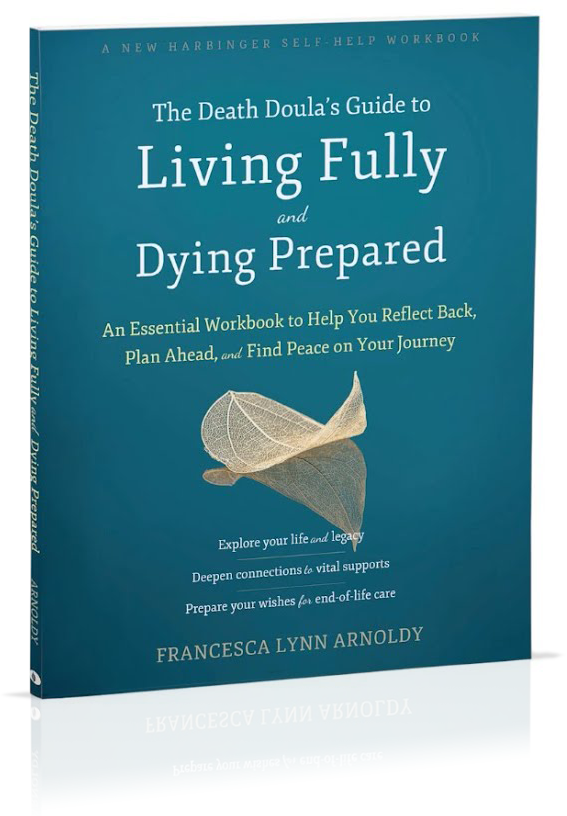Home > Resources > Francesca Lynn Arnoldy | The Death Doula’s Guide to Living Fully and Dying Prepared
The Death Doula’s Guide to Living Fully and Dying Prepared
by Francesca Lynn Arnoldy, New Harbinger Publications (2023)
Francesca Lynn Arnoldy is the author of numerous death lit books, including Cultivating the Doula Heart and Map of Memory Lane. She is a researcher with the Vermont Conversation Lab, and she was the original course developer of the University of Vermont’s End-of-Life Doula Professional Certificate programs. Francesca regularly presents on life-and-death topics with hopes of encouraging people to support one another through times of intensity.
With The Death Doula’s Guide to Living Fully and Dying Prepared, the community doula and death literacy advocate offers readers a guided tour through topics such as death anxiety, mortality awareness, compassion, and connection. This contemplative workbook is geared toward anyone wanting a more intentional approach to living and dying as well as those beginning or updating their end-of-life plans, those with serious and terminal conditions, people ready to create remembrance gifts for loved ones, and deathcare providers seeking more tools.
Among the numerous thought-provoking topics covered within the book is “memento mori,” Latin for remember that you will die. Please enjoy this excerpt as an invitation to pause, reflect, and develop (or strengthen) your own memento mori practice.
Excerpt:
Death, our perennial certainty, has always been a part of life, and humans have always struggled to reconcile its inescapability. The practice of “memento mori” is thought to have started in early Roman times during ceremonial processions following victorious battles. A celebrated military leader would parade through packed streets on a chariot. Behind the leader would be an enslaved person whose sole responsibility was to whisper continuously, “Respice post te. Hominem te esse memento. Memento mori!” Translated, this means, “Look behind. Remember thou art mortal. Remember you must die!” The aim of the tradition was to keep the worshiped leader humble and aware of the transience of glory and existence at large.
Before then and since, other cultures, religions, and spiritualities have created similar visual and verbal nods to ephemerality. Ultimately, memento mori reminders can relieve some of our mortal fear by turning our attention to the time and opportunities we have in the present. What might contemplating memento mori make possible for you as you continue on your journey toward death wellness?
Remembering Death
Since entering the deathcare field, I haven’t gone more than a few hours most days without thinking of my mortality. Sometimes, reminders—like a news story of a family saying goodbye to a beloved mother—strike me as heartbreaking. They hit close, and I think of the grief my loved ones would have experienced if the story had been ours. I imagine the world continuing to spin in my absence. I think of the projects I wouldn’t have been able to complete.
Other times, paradoxically, I find myself feeling intrigued by life’s end and yearn for the demystification that only death itself might provide. Mortal reminders also have the potential to energize and motivate me. My trusty mantra, “I’ll never have more time than RIGHT NOW,” urges me to embrace the current moment as it is the only one promised. Conversely, I sometimes feel bone tired and worn-down by the suffering of the world, which prompts me to seek balance by pausing. You can’t be passionately, robustly alive without also enjoying periods of deep rest.
I’ve come to practice a self-reminder of mortality at the end of each day, generally when saying good night to my kids or crawling into bed myself. I pause to acknowledge it is one less day in my grand total. I breathe that thought in and let it percolate as I ask myself: Do I feel proud of today or at least content with it? Did I leave anything unsaid or undone? Do I wish things had gone differently? What can I forgive within myself? What might I want to attempt or avoid tomorrow if I have the chance? What went well? What can I celebrate and appreciate?
Symbolic Reminders
Beyond this nighttime ritual, I also scatter reminders throughout my home. In my office, I have a simple, handcrafted wooden casket that serves as a bookshelf until it’s called to fulfill its ultimate purpose. As I write or teach, my eyes are regularly drawn to its contents. First, to a photo of my Aunt Nancy making one of her silly expressions I so dearly miss. It encourages me to not take myself too seriously. Next is a photo of my mom holding me as a baby. It reminds me how quickly time passes. Behind those frames, there is a painting of a tree in autumn that my daughter and I made together. It prompts me to acknowledge seasonality.
On the next shelf, I have two vision boards that nudge me to set and reach goals. The stuffed bear from my aunt with a rolled-up farewell message sits in front of a stack of poetry books I sometimes use for vigils. Scattered among the rest of the shelves, I have gifts made by my son, treasured childhood books, photo albums and scrapbooks, a talisman I crafted for my father-in-law when he was terminally ill, a painting of a sunset I worked on with a hospice client, and my death journal. Draped over it all is the dark blue “prayer shawl” a volunteer knit and gave to my Lelo for his time of dying.
Memento mori items evoke specific responses within us all. With the intention of incorporating death awareness practices to invigorate your energy for living well, what might you consider choosing as reminders? Will it be a token for your pocket, like the medallions of ancient Rome, some of which featured a skull for death, a tulip for life, and an hourglass for time? Or perhaps you’ll wear a memento mori ring as people did during the Regency and Victorian eras. Will you display visuals inspired by danse macabre (“dance of death”)—images depicting people, rich and poor, dancing with skeletons that emerged from the late Middle Ages? Or perhaps Vanitas, Dutch still-life paintings of the Baroque period that illustrated the fleetingness and vanity of life?
What calls to you?


